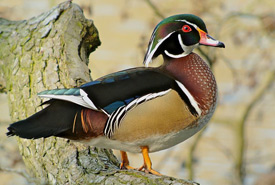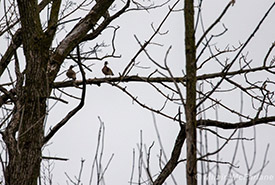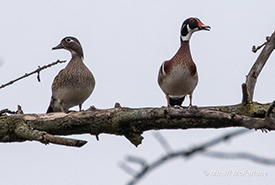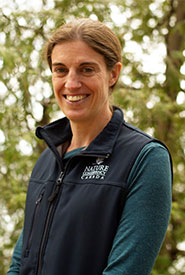Mhairi’s bird of the day: Wood duck

Wood duck (Photo by Frank Vassen/Wikimedia Commons)
Spotted on March 23, 2020
Wood duck
Aix sponsa
Aix: “diving bird” in ancient Greek
For the last 10 years, I have been recording my bird observations on my daily bike commute to work, before we started working from home in light of the COVID-19 outbreak. My colleagues, who have been enjoying my daily updates of my sightings, invited me to share my observations in this four-part blog series. Read part one here and part two here.
The next time you walk through a quiet forest, you might be startled by a rather unearthly noise, sort of a cross between a scream and a whistle. Don’t worry, you are not about to be eaten — you have likely startled a wood duck! But ducks don’t live in trees, you may exclaim! In fact, these ones do need trees for at least part of their life cycle. They actually nest in cavities, sometimes quite high up in trees in wet, swampy forests.
In early spring — even as early as mid-March — wood ducks pairs can be found walking along large tree branches high in the forest, searching for suitable nest cavities. Ducks, including wood ducks, are not exactly equipped with power tools nor woodpecker-like bills, so they must find an existing hole. They might use a natural hole from when an old branch has fallen and the tree has rotted out a little, or they might use an old woodpecker cavity.

My “First of Year” wood ducks, high in a tree. (Photo by Mhairi McFarlane/NCC)
The female wood duck lays eggs in the cavity, and her ducklings will hatch in due course. What next? Ducklings do not hatch already able to fly. Soon after hatching, the ducklings are encouraged by mom and dad to make a semi-controlled plummet — sometimes of several metres — to the ground below. With a bit of luck, mom will have chosen a cavity right above a good patch of water for a soft landing. They then make their way to nearby open water and learn to forage under mom’s watchful eye.

A pair of wood ducks (Photo by Mhairi McFarlane/NCC)
Wood ducks are a great example of how important lots of different aspects of habitat are to even just one bird. They need big trees, with cavities, which means they need a forest big that’s healthy enough to support a good population of the larger woodpeckers; pileated woodpeckers are ideal. Wood ducks also need a good patch of wetland or marshy habitat beside the forest where they can raise their young.
Here’s my ebird checklist.


